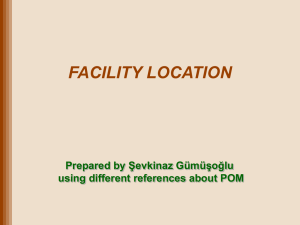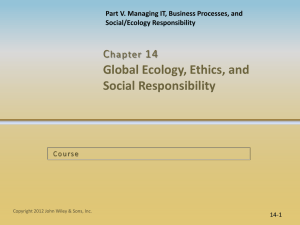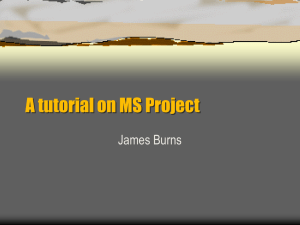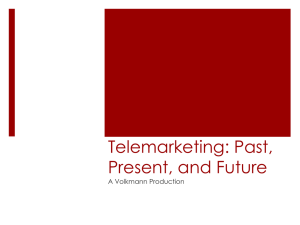ch04
advertisement
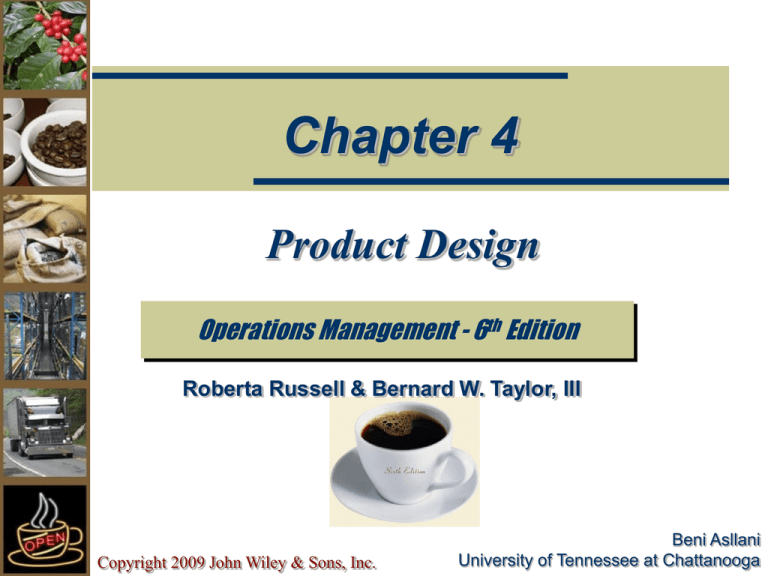
Chapter 4 Product Design Operations Management - 6th Edition Roberta Russell & Bernard W. Taylor, III Copyright 2009 John Wiley & Sons, Inc. Beni Asllani University of Tennessee at Chattanooga Lecture Outline Design Process Concurrent Design Technology in Design Design Reviews Design for Environment Design for Robustness Quality Function Deployment Copyright 2009 John Wiley & Sons, Inc. 4-2 Design Process Effective design can provide a competitive edge matches product or service characteristics with customer requirements ensures that customer requirements are met in the simplest and least costly manner reduces time required to design a new product or service minimizes revisions necessary to make a design workable Copyright 2009 John Wiley & Sons, Inc. 4-3 Design Process (cont.) Product design defines appearance of product sets standards for performance specifies which materials are to be used determines dimensions and tolerances Copyright 2009 John Wiley & Sons, Inc. 4-4 Design Process (cont.) Copyright 2009 John Wiley & Sons, Inc. 4-5 Idea Generation Company’s own R&D department Customer complaints or suggestions Marketing research Suppliers Copyright 2009 John Wiley & Sons, Inc. Salespersons in the field Factory workers New technological developments Competitors 4-6 Idea Generation (cont.) Perceptual Maps Visual comparison of customer perceptions Benchmarking Comparing product/process against best-in-class Reverse engineering Dismantling competitor’s product to improve your own product Copyright 2009 John Wiley & Sons, Inc. 4-7 Perceptual Map of Breakfast Cereals Copyright 2009 John Wiley & Sons, Inc. 4-8 Feasibility Study Market analysis Economic analysis Technical/strategic analyses Performance specifications Copyright 2009 John Wiley & Sons, Inc. 4-9 Rapid Prototyping testing and revising a preliminary design model Build a prototype form design functional design production design Test prototype Revise design Retest Copyright 2009 John Wiley & Sons, Inc. 4-10 Form and Functional Design Form Design how product will look? Functional Design how product will perform? Copyright 2009 John Wiley & Sons, Inc. reliability maintainability usability 4-11 Computing Reliability Components in series 0.90 0.90 Copyright 2009 John Wiley & Sons, Inc. 0.90 x 0.90 = 0.81 4-12 Computing Reliability (cont.) Components in parallel 0.90 R2 0.95 + 0.90(1-0.95) = 0.995 0.95 R1 Copyright 2009 John Wiley & Sons, Inc. 4-13 System Reliability 0.90 0.98 0.98 0.92 0.98 0.92+(1-0.92)(0.90)=0.99 0.98 0.98 x 0.99 x 0.98 = 0.951 Copyright 2009 John Wiley & Sons, Inc. 4-14 System Availability (SA) SA = MTBF MTBF + MTTR where: MTBF = mean time between failures MTTR = mean time to repair Copyright 2009 John Wiley & Sons, Inc. 4-15 System Availability (cont.) PROVIDER MTBF (HR) MTTR (HR) A B C 60 36 24 4.0 2.0 1.0 SAA = 60 / (60 + 4) = .9375 or 94% SAB = 36 / (36 + 2) = .9473 or 95% SAC = 24 / (24 + 1) = .96 or 96% Copyright 2009 John Wiley & Sons, Inc. 4-16 Usability Ease of use of a product or service ease of learning ease of use ease of remembering how to use frequency and severity of errors user satisfaction with experience Copyright 2009 John Wiley & Sons, Inc. 4-17 Production Design How the product will be made Simplification reducing number of parts, assemblies, or options in a product Standardization using commonly available and interchangeable parts Modular Design combining standardized building blocks, or modules, to create unique finished products Design for Manufacture (DFM) • Designing a product so that it can be produced easily and economically Copyright 2009 John Wiley & Sons, Inc. 4-18 Design Simplification (a) Original design Assembly using common fasteners Source: Adapted from G. Boothroyd and P. Dewhurst, “Product Design…. Key to Successful Robotic Assembly.” Assembly Engineering (September 1986), pp. 90-93. (b) Revised design (c) Final design One-piece base & elimination of fasteners Design for push-and-snap assembly Copyright 2009 John Wiley & Sons, Inc. 4-19 Final Design and Process Plans Final design detailed drawings and specifications for new product or service Process plans workable instructions Copyright 2009 John Wiley & Sons, Inc. necessary equipment and tooling component sourcing recommendations job descriptions and procedures computer programs for automated machines 4-20 Design Team Copyright 2009 John Wiley & Sons, Inc. 4-21 Concurrent Design A new approach to design that involves simultaneous design of products and processes by design teams Improves quality of early design decisions Copyright 2009 John Wiley & Sons, Inc. Involves suppliers Incorporates production process Uses a price-minus system Scheduling and management can be complex as tasks are done in parallel Uses technology to aid design 4-22 Technology in Design Computer Aided Design (CAD) assists in creation, modification, and analysis of a design computer-aided engineering (CAE) computer-aided manufacturing (CAD/CAM) ultimate design-to-manufacture connection product life cycle management (PLM) tests and analyzes designs on computer screen managing entire lifecycle of a product collaborative product design (CPD) Copyright 2009 John Wiley & Sons, Inc. 4-23 Collaborative Product Design (CPD) A software system for collaborative design and development among trading partners With PML, manages product data, sets up project workspaces, and follows life cycle of the product Accelerates product development, helps to resolve product launch issues, and improves quality of design Designers can conduct virtual review sessions test “what if” scenarios assign and track design issues communicate with multiple tiers of suppliers create, store, and manage project documents Copyright 2009 John Wiley & Sons, Inc. 4-24 Design Review Review designs to prevent failures and ensure value Failure mode and effects analysis (FMEA) Fault tree analysis (FTA) a systematic method of analyzing product failures a visual method for analyzing interrelationships among failures Value analysis (VA) helps eliminate unnecessary features and functions Copyright 2009 John Wiley & Sons, Inc. 4-25 FMEA for Potato Chips Failure Mode Cause of Failure Effect of Failure Corrective Action Stale low moisture content expired shelf life poor packaging tastes bad won’t crunch thrown out lost sales add moisture cure longer better package seal shorter shelf life Broken too thin too brittle rough handling rough use poor packaging can’t dip poor display injures mouth chocking perceived as old lost sales change recipe change process change packaging Too Salty outdated receipt process not in control uneven distribution of salt eat less drink more health hazard lost sales experiment with recipe experiment with process introduce low salt version Copyright 2009 John Wiley & Sons, Inc. 4-26 Fault tree analysis (FTA) Copyright 2009 John Wiley & Sons, Inc. 4-27 Value analysis (VA) Can we do without it? Does it do more than is required? Does it cost more than it is worth? Can something else do a better job? Can it be made by a less costly method? with less costly tooling? with less costly material? Can it be made cheaper, better, or faster by someone else? Copyright 2009 John Wiley & Sons, Inc. 4-28 Design for Environment and Extended Producer Responsibility Design for environment designing a product from material that can be recycled design from recycled material design for ease of repair minimize packaging minimize material and energy used during manufacture, consumption and disposal Extended producer responsibility holds companies responsible for their product even after its useful life Copyright 2009 John Wiley & Sons, Inc. 4-29 Design for Environment Copyright 2009 John Wiley & Sons, Inc. 4-30 Sustainability Ability to meet present needs without compromising those of future generations Green product design Use fewer materials Use recycled materials or recovered components Don’t assume natural materials are always better Don’t forget energy consumption Extend useful life of product Involve entire supply chain Change paradigm of design Copyright 2009 John Wiley & Sons, Inc. Source: Adapted from the Business Social Responsibility Web site, www.bsr.org, accessed April 1, 2007. 4-31 Quality Function Deployment (QFD) Translates voice of customer into technical design requirements Displays requirements in matrix diagrams first matrix called “house of quality” series of connected houses Copyright 2009 John Wiley & Sons, Inc. 4-32 Importance House of Quality 5 Trade-off matrix 3 Design characteristics 1 4 2 Customer requirements Relationship matrix Competitive assessment 6 Target values Copyright 2009 John Wiley & Sons, Inc. 4-33 Benefits of QFD Promotes better understanding of customer demands Promotes better understanding of design interactions Involves manufacturing in design process Provides documentation of design process Copyright 2009 John Wiley & Sons, Inc. 4-34 Design for Robustness Robust product designed to withstand variations in environmental and operating conditions Robust design yields a product or service designed to withstand variations Controllable factors design parameters such as material used, dimensions, and form of processing Uncontrollable factors user’s control (length of use, maintenance, settings, etc.) Copyright 2009 John Wiley & Sons, Inc. 4-35 Quantifies customer preferences toward quality Emphasizes that customer preferences are strongly oriented toward consistently Design for Six Sigma (DFSS) Copyright 2009 John Wiley & Sons, Inc. Quality Loss Taguchi’s Quality Loss Function Lower tolerance limit Target Upper tolerance limit 4-36



